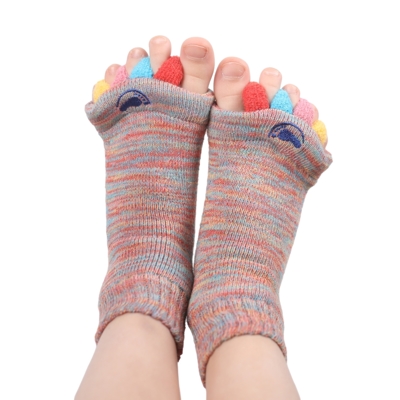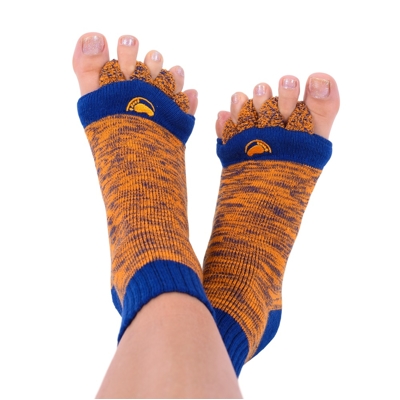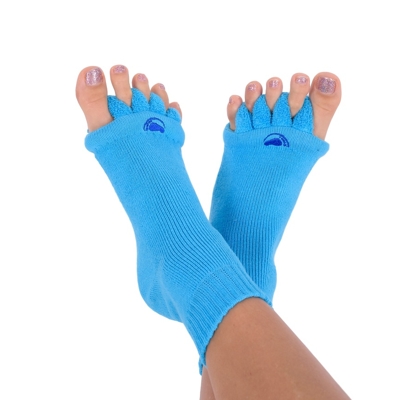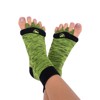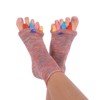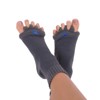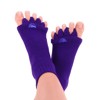The fastest relief with Foot Alignment Socks took 20 minutes says physiotherapist Veronika Kristková
 Veronika Kristková is the founder and lead physiotherapist of Fyzio Beskyd. Her practice has focused mainly on foot problems and gait disorders in children and adults. She also works as a Physio Mentor, helping other physiotherapists set up their own practice. She organizes the Kid in Motion Conference, which will take place on October 5th - 6th at Hotel Freud in Ostravice, where we are a proud partner. That is why it’s the perfect time to talk to Ms. Kristková in another of our interviews. And naturally, the subject of Foot Alignment Socks came up during the interview.
Veronika Kristková is the founder and lead physiotherapist of Fyzio Beskyd. Her practice has focused mainly on foot problems and gait disorders in children and adults. She also works as a Physio Mentor, helping other physiotherapists set up their own practice. She organizes the Kid in Motion Conference, which will take place on October 5th - 6th at Hotel Freud in Ostravice, where we are a proud partner. That is why it’s the perfect time to talk to Ms. Kristková in another of our interviews. And naturally, the subject of Foot Alignment Socks came up during the interview.
How did you start your career as a physiotherapist and what led you to this profession? What are you involved in?
 Growing up it was always my dream to work in health care. As a child, I operated on stuffed animals and dolls, I took their temperature and gave them shots. In this sense I was heavily influenced by my father who is a doctor, a neurologist. I wanted to be a doctor and work in a hospital like him. After two unsuccessful attempts to get into university to study general medicine, I decided to study biophysics and physical chemistry at the University of Ostrava. However, in my final year, I failed an exam in nuclear and atomic physics and had to extend my studies by a year.
Growing up it was always my dream to work in health care. As a child, I operated on stuffed animals and dolls, I took their temperature and gave them shots. In this sense I was heavily influenced by my father who is a doctor, a neurologist. I wanted to be a doctor and work in a hospital like him. After two unsuccessful attempts to get into university to study general medicine, I decided to study biophysics and physical chemistry at the University of Ostrava. However, in my final year, I failed an exam in nuclear and atomic physics and had to extend my studies by a year.
I wanted to remain at the university, so I applied to the Physiotherapy and Medical Rehabilitation Department, which was quite young at the University of Ostrava at that time. I graduated with a bachelor's degree and after about three years of working at the University Hospital in Ostrava, during a conference where I was lecturing I was offered a job at the University Hospital in Olomouc. I accepted the offer and then finished my master's degree at Palacký University.
I have always been interested in feet and the way people walk. As a physiotherapist, I began working primarily with adults who had experienced strokes and other neurological problems. After I moved to Janské Lázně in the Krkonoše Mountains to be with my partner, I became more involved in children's issues, especially children with neurodevelopmental disabilities.
When I returned to Northern Moravia, I founded my own company and this year we are celebrating our tenth anniversary. Today there are six of us working there, and each of us focuses on something a little different. Personally, I am still focused mainly on feet and walking. I mostly specialize in more severe neurological and orthopedic defects and specific gait disorders. In my practice, I see some very serious conditions. Therefore, I work with some great specialists - orthopedic surgeons, neurologists and ortho-prosthetists - to provide truly comprehensive care for my clients.
Can you tell us more about the Kid in Motion Conference you are organizing on October 5th – 6th? What is the main goal of this conference and what are your expectations?
The main goal of the conference is to draw the attention of medical professionals to the movement of children. We try to look at movement from the many different perspectives of various professions. It’s a topic that many people like to talk about, but we feel the message always seems to get a little lost.
Our conference is not only intended to show the enormous importance physical activity has for children and adolescents, but we also want to give examples from our practice to inspire other professionals. We want to show that movement is essential not only for neurologically and orthopedically healthy children, but also (and especially) for children with some form of handicap. Even children with major locomotor problems and disorders should play sports regularly. Therefore, at the conference you will meet experts from many disciplines, starting with physiotherapists and doctors, but also coaches, occupational therapists, psychologists and representatives of patient organizations. One of the speakers is a long-standing pediatric client who had a less than ideal start in life, was born very prematurely, and yet today is active in sports and even at a high level. It will certainly be interesting to hear his perspective on sports.
The professional conference is followed by a festival of the same name. Who is it intended for and how is it related to the conference?
The festival is intended primarily for the general public and families with children. We believe that the most important basic exercise habits are acquired within the family, because children learn through imitation. And if the parents don’t lead and encourage an active lifestyle for their children, professionals have a slightly more difficult task. So, we want to show parents that regular exercise is an essential part of life that doesn’t require much. We want to introduce families to movement in a playful way, to inspire them and, most importantly, to get parents moving with their children. Because as I said, the family provides the foundation.
The festival follows the conference, where there will be numerous lectures by some of my colleagues who also have plenty to say, and I am encouraged by the considerable interest of the professional community in this event. I believe that they too can gain a great deal of information and perhaps even some inspiration for their practice.
How much do you think the COVID-19 pandemic has affected the movement of children? And how do you view modern technology and digital devices (tablets, phones, TV...), which are an integral part of many children's lives from a very young age?
An excellent question. COVID-19 and its impact on the exercise habits of children is the topic of one of the lectures that participants will hear at our conference. I myself am quite curious because in my opinion, the COVID-19 pandemic revealed a problem that has been growing for years. Namely, the fact that children largely lack movement in their lives. The real pandemic is inactivity and the consequences associated with it, which ultimately cost us and our health system a great deal of money. It is well established that a lack of adequate physical activity is one of the negative factors contributing to the onset and development of many “civilization diseases”.
Which brings me back to the importance and impact of families and the influence of parents on their children. Nobody else is going to do it for us. And it’s not about the number of sports clubs we sign our child up for.
Often it’s enough to take an "ordinary" trip to the mountains instead of going to the mall, walking instead of driving, playing simple games like tag, hide and seek, etc. If the child sees the parent exercising regularly (and ten or fifteen minutes a day is really enough), the he/she will better accept movement as an integral part of life.
I would not primarily blame the availability of modern technology for the fact that children are moving less. We should realize that these devices are merely tools and it is up to us how we use them. It’s a convenient excuse to blame everything on the constant presence and availability of mobile telephones and tablets. But let’s think about ourselves. What do our children see more often? Parents in Motion or sitting with a phone in their hand?
What are the most common mistakes parents make when encouraging their children to be physically active and how can these be avoided?
I am convinced that the vast majority of parents do the best they can in raising their children, and they all want their children to be healthy and develop properly. We all make mistakes from time to time and that’s part of life. The important thing is to learn from them and not compound them, because when it comes to movement, many factors come into play. Very rarely do we see a problem arise due to a single negative thing.
I don't like to scare parents; I don't think that has any long-term effect. I always explain to them in the office to think of their children's motor development as the constant balancing of the two pans of a scale, which they can influence by adding positives, such as plenty of varied exercise and appropriate footwear. And if they see a problem, they shouldn’t wait. Rather, they should seek out a pediatric physiotherapist rather than let bad habits become the norm. I am not an advocate of the wait-and-see approach and I know that experienced pediatric physiotherapists can advise parents on many issues. The sooner they start addressing any issue, the less time, energy and sometimes even money it will cost.
You have experience with Foot Alignment Socks. What benefits do you personally see in wearing them? Do you also use them in your practice? Can you think of any time when Foot Alignment Socks had a positive impact on a patient?
I’ve used Foot Alignment Socks for many years now and I swear by them. I always put them on when I feel like my feet are tired after longer or more intense exercise or doing a sport that requires special footwear that restricts the foot like downhill skiing or, lately, also inline skating. In these cases, Foot Alignment Socks help me recover.
Among my clients, I recommend Foot Alignment Socks to a large number of adults who come in for foot consultations. And the spectrum of use is truly broad. They are great for treating bunions (hallux valgus), transverse arch strains, pain anywhere in the soles and instep, people with fatigued and swollen feet, pregnant women experiencing changes in their feet, and recovering athletes.
The fastest effect I have ever seen with Foot Alignment Socks was a case where I recommended them as first aid to a woman experiencing instep pain due to strain on her transverse arch after pregnancy. After about twenty minutes she wrote me that the pain was gone and she didn’t have to take any pain relievers. That was so fast, even I was surprised.
How do you use Foot Alignment Socks in the care of children’s feet?
Since you introduced your Kid’s line, I’ve been recommending Foot Alignment Socks for children who have various toe deformations and for young athletes – typically climbers, swimmers, gymnasts, hockey players, footballers – any child whose feet are stressed by sports or the restrictive footwear necessary to excel in a given sport, as well as those who play sports involving hard impacts and landings. Foot Alignment Socks greatly help in their recovery and provide excellent compensation.
What advice would you give to parents who are trying to make sure their children’s feet develop in a healthy manner?
The mere fact that the parents are taking an active interest in their child’s feet is a good sign. As I said already, sooner is always better than later in physiotherapy, and every reasonable physiotherapist will tell you that prevention is the best. Fixing any physical or movement problem generally takes a long time. So, I would definitely recommend that parents look at their children’s feet, not while standing, but while they are in motion, doing any normal activity – jumping, running, squatting… And to come in as soon as anything doesn’t seem right, whether it be some asymmetrical position of the feet, curling of the toes, collapsed ankles, toes turning in or out, tiptoeing, or basically any deviation or peculiarity anywhere in the body or in movement. A good physiotherapist will give the child a general examination anyway.

As far as foot development is concerned, I definitely recommend that parents expose their children to varied terrain. Of course, the best and most natural way is to get outdoor exercise, but parents can also provide variable terrain at home - for example, by using different stimulation carpets, orthopedic tiles, sensory pads, etc. On the one hand, the child will get a variety of sensations, but the feet will also be forced to work.
Shoes are a separate chapter in and of themselves. Shoes should allow the feet to work actively without restriction or any noticeable change to gait.
Another recommendation concerns movement in general, and here the adage "everything in moderation" applies. Children should engage in physical activity that is appropriate for their age. Not too much, not too little. Unfortunately, in practice we see two completely opposite extremes. In my office, I see children who really hardly move at all, their parents drive them everywhere, and then they usually spend their time on the PC, mobile phone or TV. The most fun they have with their parents is shopping for a few hours in the mall.
And then we have the young athletes who are forced by their coaches (and sometimes even parents) to do too much. These children are more likely to get injured, lose motivation, and moreover, they lose the joy of exercise. Both extremes are bad and one of the aims of the conference and festival is to change this. Keep your fingers crossed that we can make it happen.
___
We would like to thank Ms. Veronika Kristková very much for her extensive and insightful interview and wish her and her entire team a successful Kid in Motion Conference and Festival. We are looking forward to it ourselves.
If you would like to learn more about Kid in Motion, the festival will take place October 7th at Hotel Freud in Ostravice.

Photo: archive of Veronika Kristková, IG: fyziobeskyd_edu


